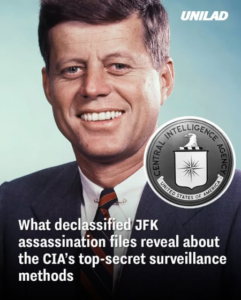Declassified JFK Assassination Files Reveal CIA’s Top-Secret Surveillance Methods
In recent years, declassified files surrounding the assassination of President John F. Kennedy have offered new insights into the CIA’s top-secret surveillance methods, revealing the depth of intelligence operations leading up to and following the tragic event. These files, which were previously kept under wraps for decades, shed light on the covert tactics used by the agency and have sparked renewed debates on the extent of their involvement in the investigation and the broader implications of surveillance during that era.
The Declassification Process
The release of JFK assassination-related documents began in earnest in the 1990s, culminating in the 2017 release of thousands of additional files after a long legal battle. These documents included detailed accounts of the CIA’s surveillance activities in the years leading up to the assassination on November 22, 1963. While many of the documents were already available to historians, the newly declassified files provided previously unknown information that cast new light on the CIA’s surveillance capabilities and its role in monitoring key figures involved in the assassination.
Surveillance of Lee Harvey Oswald
One of the most significant revelations from the declassified files centers around the CIA’s surveillance of Lee Harvey Oswald, the man accused of assassinating President Kennedy. Oswald’s movements and communications were closely monitored by the CIA both before and after he defected to the Soviet Union in 1959. After his return to the United States in 1962, the CIA continued to keep tabs on him, though the agency was not able to piece together the full extent of his activities leading up to the assassination.
The files show that the CIA had multiple surveillance methods at their disposal, including wiretaps on Oswald’s communications, the use of informants to track his movements, and even the placement of undercover agents in key locations to gather intelligence. The CIA’s use of electronic surveillance, including phone tapping and mail interception, was advanced for its time.
Despite these efforts, the documents reveal that there were significant gaps in the intelligence community’s ability to connect the dots between Oswald’s activities and the eventual assassination of Kennedy. This has led to questions about whether more could have been done to prevent the tragedy or whether the CIA intentionally withheld certain information for reasons unknown.
CIA’s Role in Monitoring Foreign Governments
The declassified files also offer a glimpse into the CIA’s extensive monitoring of foreign governments and their potential influence on domestic events. In the years leading up to the assassination, the CIA had been focused on tracking the Soviet Union’s activities, particularly in Cuba. The agency kept an eye on individuals with potential communist ties, including Oswald, whose defection to the Soviet Union had raised red flags.
Additionally, the files suggest that the CIA was involved in covert operations to monitor Cuban exiles and other foreign nationals in the United States who could have had ties to the assassination. This surveillance was part of the broader Cold War strategy, where the agency used intelligence operations to assess potential threats to national security.
New Insights into the CIA’s Covert Tactics
The declassified documents also reveal new details about the CIA’s use of covert surveillance tools. These included methods like hidden microphones, electronic listening devices, and even the use of spy satellites in some cases. The agency had already been working on expanding its technological capabilities, and these methods were essential in monitoring foreign figures deemed to be of national security concern. However, the files also highlight how these technologies were sometimes used domestically, raising questions about the scope of government surveillance during the era.
The Ongoing Debate
The release of these files has reignited debates about the CIA’s role in the JFK assassination and the broader implications for civil liberties. While the files reveal extensive surveillance operations, they do not provide conclusive evidence of direct CIA involvement in the assassination. Instead, they underscore the complexity of intelligence-gathering methods during the Cold War and the challenges of preventing political violence when information is fragmented or withheld. The ongoing debate around these declassified files continues to fuel speculation and calls for further investigation into the circumstances surrounding JFK’s death.


